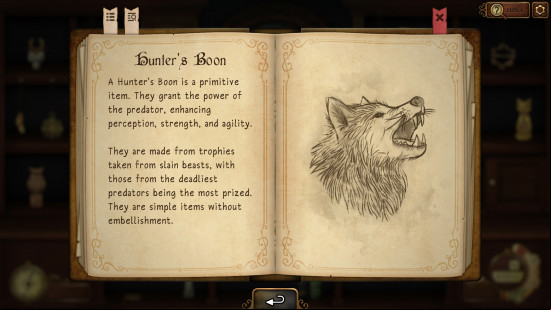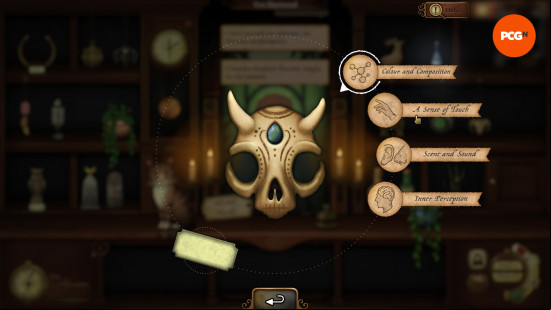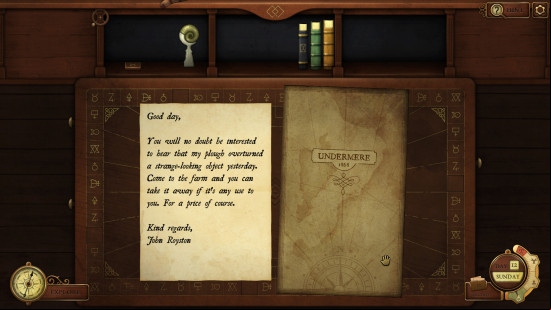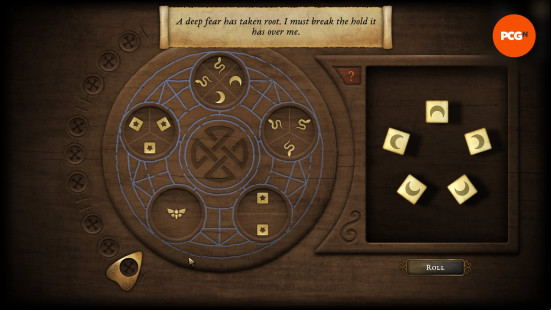Undermere is a unique little place. In Bad Viking's debut game, Strange Horticulture, its residents were embroiled in the peculiar machinations of a forest cult intent on summoning the mysterious Woken Dendrue. Now, in its sequel, a conspiracy of ravens has descended upon the township; people are afraid to leave their homes, cautious of what appears to be a symbol that something bad is happening. This ill omen is good news for you, though – as the temporary proprietor of local curios store Strange Antiquities, you're the first port of call for protection totems, warding spells, and mood-lifting enchantments. Business is booming.
If you're unfamiliar with Bad Viking's supernatural Strange Antiquities (and its much-beloved predecessor, Strange Horticulture) tasks you with running a store in a quaint fantasy hamlet. Villagers come looking for specific relics, and you need to work out which one to give them. You'll spend your time flicking through the pages of worn tomes and exploring the local area to find more artifacts and book chapters, all while fending off a creeping dread nestled in the pit of your stomach.
On paper, it sounds like there's not much room to innovate on Strange Horticulture – different shop, different artifacts, same great point-and-click adventure. It's an inherent struggle for an often mechanically simple genre. As our Amerzone review says, a fresh splash of paint alone can only do so much, so how then does Strange Antiquities become its own game? Thankfully, after just a brief hour with a private demo, my worries have been squashed.

I'm immediately presented with a customer looking for a replacement Hunter's Boon. I turn to my cabinet of curiosities, peering at the oddities on offer. There are pendants made of bone, rocky ornaments emblazoned with odd symbols drawn in suspicious red liquids, and carvings of forest animals. I open my guide to the store's inventory, think for a few moments, and quickly locate the Hunter's Boon. So far, so good.
But requests only get harder. A woman asks for an item not listed in my book. Instead, I have to flick back to the index, where I spot descriptors and the items they relate to (curses, for example, are referenced in Lamb's Syphon) and alternative names for objects. Putting two and two together, I give the customer her curio, and she leaves satisfied. I attach a label to it – these are now fully customizable, by the way – with the alternative name included to save me some flicking back and forth.

A day or so es, and I'm presented with a new book from one of the shop owner's eccentric academic colleagues. After tutting over the fact that Strange Antiquities has been left in the hands of "an apprentice," she swoops out of the store, leaving you with a gorgeous tome filled with new symbols. It quickly becomes apparent that these glyphs will appear on future artifacts, and that I'll have to translate them to ensure my customers receive the right boons. It's yet another complication, but it never becomes a frustration – in fact, it's easily one of my favorite new additions to the game.
I'm then approached by a gentleman looking for an eerie necklace, which, when raised to the ear, emanates a gentle, snake-like hiss. While you'd simply drag a plant under the microscope in Strange Horticulture to examine its quirks, you can now use your senses to analyse objects more carefully. Again, it's another layer of complexity to what, on paper, felt like an already bulletproof system.

Exploration is different here, too, as you can now wander around Undermere at your leisure. In Strange Horticulture, you had to fill up the 'Will to Explore' meter by either watering plants or getting customer requests right, while in Strange Antiquities, there's a lot more opportunity to explore the map. The demo confined me to the village itself, with nearby POIs just begging to be explored.
I recover some stolen valuables hidden behind Undermere's rotting penitentiary, then I pay the winery next door a visit to recover some artifacts from its basement. Instead of visiting disparate, oftentimes meaningless locations and hoping for the best, this new system, while more streamlined, immerses you in the wider world of Undermere.

Speaking of meaningless, if things begin to get out of hand, you're now presented with a new recovery system. Similar to Strange Horticulture, making consistent mistakes during the day makes your internal sense of dread rise to the surface, leaving you entirely incapacitated. You'll have to solve a puzzle sequence to piece your fragmented mind back together, represented by a series of stone shards in Horticulture, which you put together to form a seal. In Antiquities, that system has been replaced with a dice roll, where you'll have to roll the correct combination to break a series of seals. Rolling an X adds to your dread meter, leading to a game over if you accrue enough of them.
While it took me a few moments to get my head around it, I grew to prefer this to the old system. There's an element of chance and higher stakes, which is more exciting than having to piece a puzzle back together. There's also a satisfying 'thunk' as the wooden dice hit the ling, and I found myself having to think more deeply in general.

As the sun sets on my second day in Undermere, I'm given a choice. My last patron of the day barrels into the store, informing me that her 'friend' has a bad habit of stealing her jewelry and that, in order to stop her, she wants to buy an enchanted item that she can, in turn, have her acquaintance steal. The game informs me that this choice will have consequences further down the line, so do I give her an item that will punish, or one that instills fear? The former implies that something more drastic will happen, while the latter seems to let the thief off more lightly. I opt for the former – how dare she steal this woman's things – and, as we fade into the night, the demo comes to a close. Quite the cliffhanger.
As someone who loved the first game, I had my reservations about whether Strange Antiquities could set itself apart. Undermere's charm is certainly what enticed me in the first place, but I wasn't sure if it could carry a sequel. Thankfully, Antiquities takes everything Horticulture did well and enhances it, adding more variety to item analysis and letting you explore its unique world. After just an hour with Antiquities, I'm desperate to uncover all of its dark secrets – Jupiter needs more pets, those ravens need dealt with, and there are eerie games afoot: the question is, where do you even begin?
